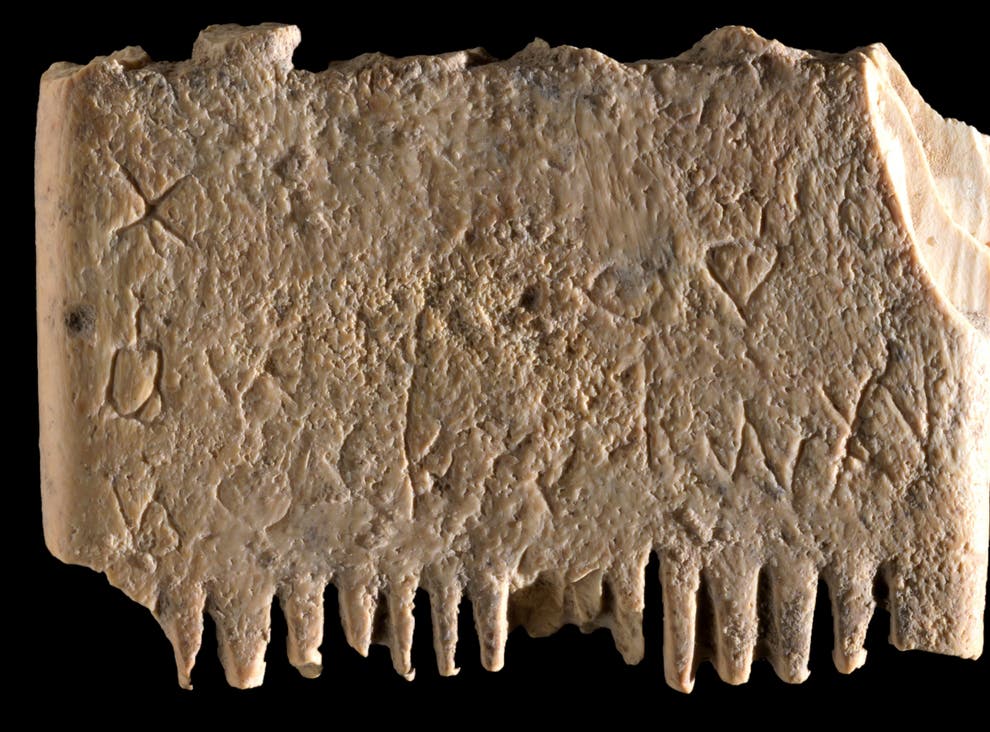
A small ivory comb found at an archaeological dig in Israel has an interesting message written on it: May this tusk root out the lice of the hair and beard.
But more important than this advice is the ancient alphabet it was written in. The inscription is the oldest complete sentence ever written using the ancient Canaanite alphabet.
The comb was found in 2016 in the ruins of the ancient city of Tel Lachish, in Israel. Archaeologists believe the comb was made around 1,700 BCE, which means it is about 3,700 years old.
The comb is about 3.6 centimetres wide and 2.5 centimetres tall. Its teeth had mostly been broken off, but archaeologists could tell that there had been thick teeth on one side of the comb to untangle hair, and fine teeth on the other side to help remove head lice and their eggs (nits).
Head lice are small, wingless insects that live on the human scalp and feed on human blood. Archaeologists have found evidence of lice and nits, as well as lice combs, with ancient human remains all over the world. The oldest example is fossilized nits found in the hair of a person who lived in Brazil 10,000 years ago.
What makes this comb especially interesting is the words that are written on it.
The comb had been handled by many people since it was discovered. However, no one noticed there was writing inscribed on it until recently.
Madeleine Mumcuoglu is an archaeologist who studies parasites—organisms that live and feed off of another organism. Dr. Mumcuoglu was examining the comb under a microscope to look for remnants of lice.
She took a picture of the comb, and when she zoomed in, she realized something was engraved on it. There were seventeen tiny symbols, from 1 mm to 3 mm wide.
Daniel Vainstub is a paleographer—someone who studies ancient writing. He recognized that the symbols were letters from the Canaanite alphabet.
The Canaanites were a group of people who lived in the Near East (what we know today as Israel, Palestine, Lebanon, Syria and Jordan) in ancient times. They developed the first version of the alphabet that eventually evolved into the letters that we use today.
The letters on the comb are from the earliest stage of this alphabet. It’s the oldest complete sentence ever found in this ancient script.
The earliest writing systems emerged around 3,200 BCE. These systems generally used pictures to represent words and sounds. They contained many symbols and could be very difficult to learn. For example, Egyptian hieroglyphics contained more than 1,000 characters.
The Canaanite writing system was invented around 1,800 BCE. It used only a few dozen symbols, or letters, which each represented a single sound. These letters could be combined and moved around to form words.
This alphabet was the foundation of many later alphabets that are still used today, including Hebrew, Greek, Cyrillic, and the Latin alphabet this article is written in.
The inscription will help archaeologists learn more about the language spoken by the Canaanites, as well as about how they dealt with the problem of head lice.
THINK & DISCUSS
- The article mentions different alphabets: Hebrew, Greek, Cyrillic and Latin. Find examples of letters from those alphabets. Compare (you could make a T-chart, listing similarities and differences) and discuss.
2. This ancient lice comb doesn’t look very different from lice combs still used today. Find images online and compare. What are some other ways we get rid of lice today?
3. This year is 2022 CE. The lice comb was made in 1,700 BCE. What do CE and BCE mean? Can you draw a timeline to show these years? Now add other dates from the article: 1,800 BCE, 3,200 BCE and “10,000 years ago.” Which one is the oldest date?
4. Lice don’t like dirty hair! They actually live mostly in clean hair. Want to know more about lice? Here’s a fact sheet from the North Dakota government with myths–and facts: https://www.health.nd.gov/sites/www/files/documents/Files/HSC/SHS/Head_Lice/Myths_and_Facts.pdf
5. Have you been scratching your head just reading this article? Here’s some information about why we get itchy when we’re thinking or talking (or reading) about lice: https://www.licedoctors.com/blog/phantom-lice-syndrome
LINKS
Ancient writing systems https://howforkids.com/history-of-writing-systems-for-kids/
Lice Facts https://www.pestworldforkids.org/pest-guide/lice/
Archaeology for kids https://www.nps.gov/subjects/archeology/archeology-for-kids.htm







